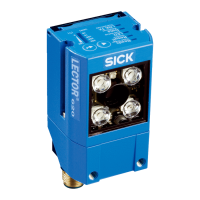ONLINE HELP SOPAS Chapter 5
LECTOR®620
Parameters
8013778/Y269/2013-11-27 © SICK AG · Germany · All rights reserved · Subject to change without notice 147
5.10.12.1.4 Debouncing
Depending on the configuration of the Control parameter, the Debouncing parameter is
used to specify the distance in mm or time in ms for which the signal must at least be pre-
sent at the external input. If the value is not achieved, the signal is not identified.
Depending on the application, this value must be modified in accordance with the required
reading pulse rate.
5.10.12.2 Sensor / Result 2
The Sensor / Result 2 group contains the parameters for modifying digital input 2.
5.10.12.2.1 Control
The Control parameter is used to choose between configuration with units of length or con-
figuration with units of time.
• T
RACK CONTROLLED: The configuration is based on track increments in mm that are either
generated by the configuration software (SOPAS) or via the CAN interfaces or are generated
via an incremental encoder on the digital input.
• T
IME CONTROLLED: Configuration is based on time information in ms.
5.10.12.2.2 Sensitivity
The Sensitivity parameter is used to choose between edge control and level control.
• E
DGE: Depending on the configuration of the Logic parameter, the digital input reacts to
the change between Low (0) and High (1). A permanently present signal is ignored.
• L
EVEL: Depending on the configuration of the Logic parameter, the digital input reacts to
a permanently present signal.
5.10.12.2.3 Logic
The Logic parameter is used to select the polarity for the Sensitivity parameter.
• N
OT INVERTED: The digital input reacts to a rising edge, i.e. to the change from Low (0) to
High (1) or a permanent High signal (1).
• I
NVERTED: The digital input reacts to a falling edge, i.e. to the change from High (1) to Low
(0) or a permanent Low signal (0).
5.10.12.2.4 Debouncing
Depending on the configuration of the Control parameter, the Debouncing parameter is
used to specify the distance in mm or time in ms for which the signal must at least be pre-
sent at the external input. If the value is not achieved, the signal is not identified.
Depending on the application, this value must be modified in accordance with the required
reading pulse rate.

